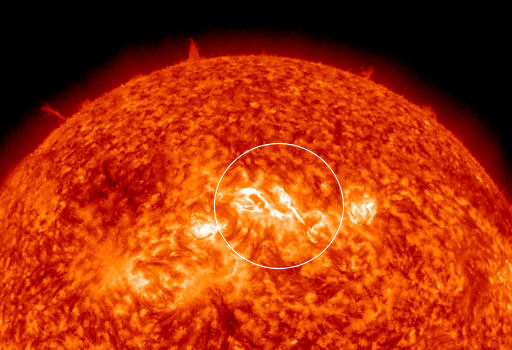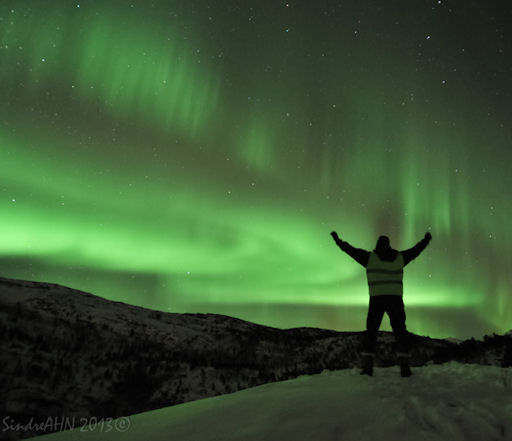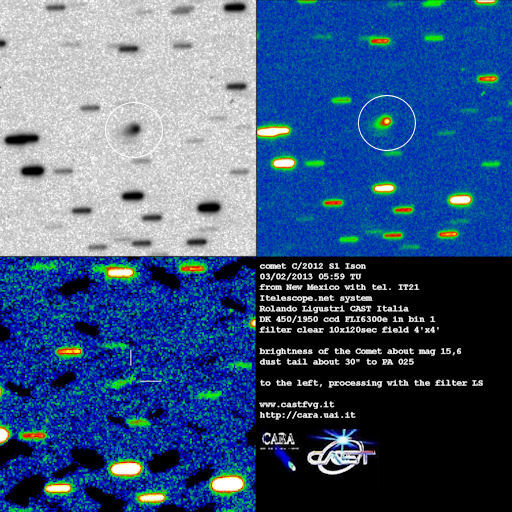Hang the Transit of Venus on your wall! Hubble-quality images from NASA's Solar Dynamics Observatory are now available as metallic posters in the Space Weather Store. | | |
SEE MERCURY AT SUNSET: The planet Mercury is about to make its best apparition of the year for backyard sky watchers. Look west at sunset for a piercing pink planet surrounded by twilight blue. [video] [photo gallery]
EARTH-DIRECTED ERUPTION: On Saturday, February 9th, around 0640 UT, a magnetic filament in the sun's northern hemisphere erupted, hurling a coronal mass ejection (CME) toward Earth. NASA's Solar Dynamics Observatory captured the UV flash from the underlying C2-class solar flare:

The CME, which was captured in flight by the Solar and Heliospheric Observatory, billowed away from the sun at 800 km/s. The bulk of the cloud looks like it will sail north of Earth. Nevertheless, a glancing blow is possible as shown in this 3D model of the CME prepared by analysts at the Goddard Space Flight Center. High-latitude sky watchers should be alert for auroras on Feb. 12th when the CME passes by. Solar flare alerts: text, voice.
Realtime Space Weather Photo Gallery
NORTHERN LIGHTS: As predicted, a solar wind stream hit Earth's magnetic field on Feb. 8th, sparking bright auroras around the Arctic Circle. "It was mindblowing," says Sindre Nedrevåg who watched the show from Bodø, Norway:

"Along with the Milky Way and a meteor we saw that lasted for three long seconds, the Northern Lights were just awesome," adds Nedrevåg. It was a good night to be outdoors.
Tonight could be another good night. NOAA forecasters estimate a 25% chance of polar geomagnetic storms as Earth's magnetosphere continues to reverberate from the solar wind impact. Aurora alerts: text, voice.
Realtime Aurora Photo Gallery
COMET ISON SPROUTS A TAIL: Comet ISON, which is plunging toward the sun for a bright and fiery encounter in late 2013, has just sprouted a tail. It's not much--yet--but that is because the comet is still in deep space near the orbit of Jupiter. On. Feb. 3rd, amateur astronomer Rolando Ligustri photographed the development using a robotic telescope in New Mexico:

Comet ISON doesn't look very impressive now as it glides through the cold vacuum more than 600,000 km from Earth, but its appearance will improve later this year. On Nov. 28th, ISON is going to glide through the sun's atmosphere only 1.1 million km above the stellar surface. It could emerge from the encounter glowing as brightly as the full Moon, visible in broad daylight near the sun. If so, today's budding tail would likely grow into a garish appendage that wows observers in both hemispheres--no telescope required. Stay tuned for updates.
Update: NASA's Deep Impact spacecraft has also observed Comet ISON's sprouting tail. Click here for a video.
Realtime Comet Photo Gallery
Realtime Space Weather Photo Gallery
Realtime Noctilucent Cloud Photo Gallery
[previous years: 2003, 2004, 2005, 2006, 2007, 2008, 2009, 2011]

